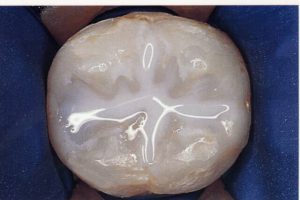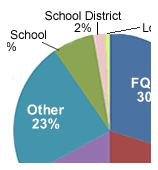Caries Prevention, Risk Assessment, Diagnosis, and Treatment. Module 2: Caries Prevention
2.4 Dental Sealants
 Properly applied dental sealants are an excellent pit-and-fissure caries preventive measure. Sealants should be applied as tooth morphology (deep or uncoalesced pits and fissures) and risk classifications dictate. Sealants are effective when placed over incipient lesions, where it has been shown that entombed bacteria die and the caries process stops following sealant placement. Sealants have also been shown to reduce the salivary level of caries-causing bacteria.48,49 Placing sealants on the teeth of patients at high risk for dental caries isolates pits and fissures at sites that can harbor cariogenic bacteria and helps eliminate the dental caries infection.
Properly applied dental sealants are an excellent pit-and-fissure caries preventive measure. Sealants should be applied as tooth morphology (deep or uncoalesced pits and fissures) and risk classifications dictate. Sealants are effective when placed over incipient lesions, where it has been shown that entombed bacteria die and the caries process stops following sealant placement. Sealants have also been shown to reduce the salivary level of caries-causing bacteria.48,49 Placing sealants on the teeth of patients at high risk for dental caries isolates pits and fissures at sites that can harbor cariogenic bacteria and helps eliminate the dental caries infection.
Sealants are often placed in venues such as dental sealant programs conducted in schools. In these programs, sound pits and fissures as well as those that have incipient and obvious caries are sealed. It is appropriate to seal incipient and carious teeth in school-based programs because the dentist does not know when the child will be able to visit a dental office or clinic for treatment, and sealants will at least slow the disease process.
Sealants are not 100 percent protective against dental caries, and even sealed teeth can decay. It has been shown that 10.8 percent of teeth with incipient lesions that have been sealed progress to frank decay, compared with 51.8 percent of teeth with incipient lesions that have not been sealed. For sound sealed teeth, 8.1 percent have been shown to decay, compared with 12.5 percent of sound unsealed teeth.50
Selective placement of sealants on patients’ teeth that show early evidence of carious activity can improve the cost-effectiveness of sealant placement. Placing sealants over carious as well as non-carious occlusal surfaces can be safe and effective.51,52 Sealants should be checked at recall to ensure that they are intact, and teeth should be resealed if necessary.
Category: General
